
Did you know that there is a natural hot spring in Singapore? That is right, two of them to be precise, although only Sembawang Hot Spring is actually located on the main island of Singapore. The other is not accessible to the public as it is found on the military island of Pulau Tekong.
In this article we explore everything you need to know before visiting Sembawang Hot Spring, from what there is to do there to practicalities around getting there, its facilities and the history behind this natural phenomenon.
Whether you are a local or a visitor, this is one of those unique and unexpected things to do in Singapore.
The history of Sembawang Hot Spring
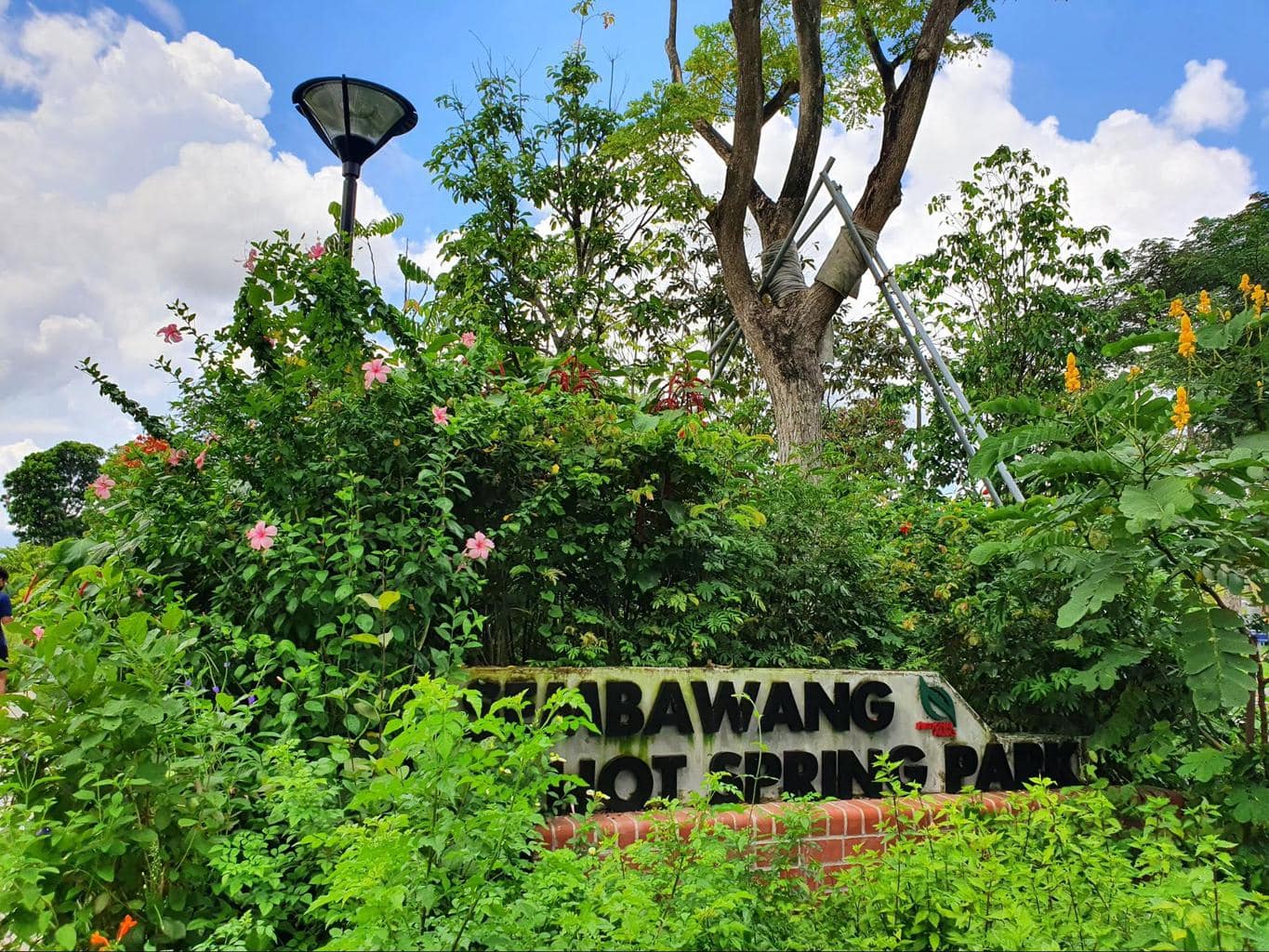
This unusual occurrence of hot waters in the area was discovered in 1908 by a municipal ranger in a pineapple plantation that belonged to a Chinese merchant by the name of Seah Eng Keong. Samples of the water were taken and sent to London for analysis after which it was confirmed that the 65 degree Celsius water was safe for drinking.
The merchant, a savvy businessman, decided to turn the area into a tourist attraction named Sembawang Hot Spring Park and started to advertise it on local newspapers encouraging people to visit the hot spring and water bottling plant.
In 1921, the company was bought by soft drink experts Fraser and Neaver (F&N) who started to bottle the water under various brands ultimately building a proper bottling plant in 1933.
With the Japanese occupation during WWII, the area was turned into a recreational space for officers and the former hot spring was brought back. Sadly, an air raid by Allied Forces in 1944 damaged the area and the hot spring ceased to naturally occur until the 1960s.
F&N relaunched the bottling plant in 1967 and announced plans for a spa complex that never materialised because experts could not find the source of the spring (it is believed the hot spring water flows from as far as Bukit Timah).
In 1985 the Government purchased the land with plans to expand the Sembawang Military Base and cover the hot spring, but the locals opposed the plans and managed to preserve the area.
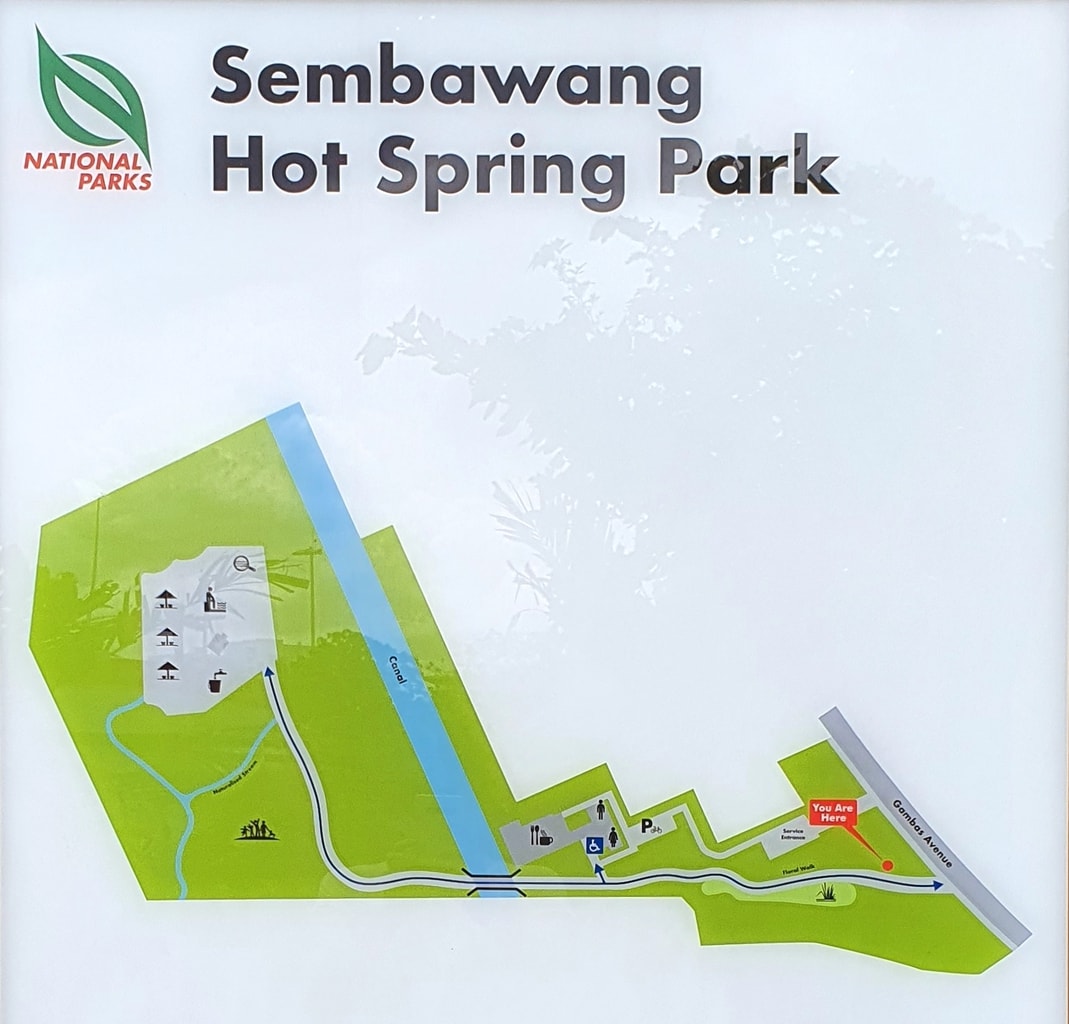
Finally, in 2002, the Government decided to restore the area, build pipes to channel the water and leave the hot spring park as a free recreational space open to everyone to come enjoy the wellness and health benefits of the water.
NParks developed the area into a small park in 2018 and further enhancements were carried out at the beginning of 2020 which added gardens, educational panels about the area and the hot spring, a proper egg cooking station, a cascading pool, bathrooms and other facilities to make the experience more enjoyable for everyone.
Where does Sembawang Hot Spring water come from?
When I first heard about Sembawang Hot Spring I thought it must be something artificial created to provide entertainment and fun. I did not expect it to actually be a naturally occurring phenomenon like the ones you find in Korea, Taiwan, Japan, Cape Town or Andorra. But it is.
The water at Sembawang Hot Spring comes from up to 3km below the ground and is heated up by layers of hot underground granite rock masses to a temperature of 100-150 degrees Celsius, the hot rock masses are known as the Bukit Timah Granite.
Water seeps from the surface and flows through faults on the rocks and gets heated as it moves at a rate of 25-30 degrees Celsius for every 1km that it gets closer towards the center of the Earth.
Because of pressure, this same water eventually flows back up to the ground level at the temperature that we now see, 65-70 degrees.
Why visit Sembawang Hot Spring?
Besides the obvious reason that it makes for a fun and different day out, the hot spring is known for its water properties, believed to help relieve all sorts of ailments, from rheumatism to arthritis, acne and psoriasis.
It is the water’s high concentration of sulphide (3 times the amount found in tap water), which you will smell from the moment you get closer to the pools, that give it its unique properties.
Hot spring water across the world is revered for the same reason and you will see lots of elderly splashing themselves in hot spring water, dipping their entire legs in their buckets and spending time soaking in the goodness, literally.
What to do at Sembawang Hot Spring Park
Sembawang Hot Spring Park is rather small and you will quickly have seen it all. Below you will find a list of all the things to do there, you should allow around 1.5h if you plan to cook eggs (it will take a good hour to cook them to the runny version you get with your kaya toast).
Enjoy the foot bath area
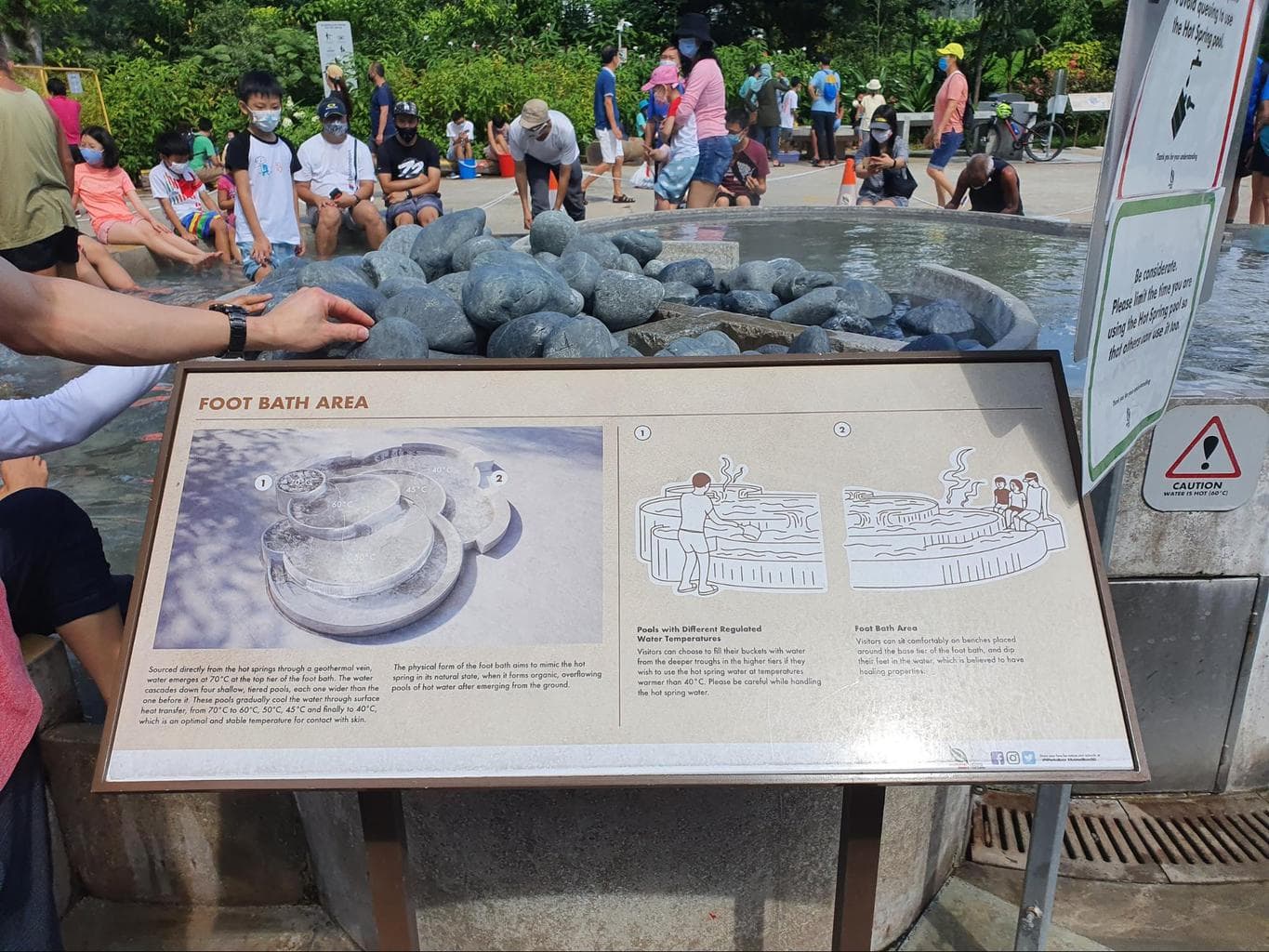
The main draw to Sembawang Hot Spring is indeed the hot spring water that comes from deep down below the Earth’s surface. The foot bath area is where you can take water to enjoy in your own bucket or directly dip your feet into (if you can stand the heat).
There are 5 pools, the hottest of which springs out at 70 degree Celsius and flows down to the “coolest” pool at the bottom which is supposed to be at 40 degree Celsius, the optimal temperature for long safe exposure.
As the water flows down, the temperature drops from 70 to 60, 50, 45 and finally 40 degrees and the pools become larger, you can see the drawing in the photo above. The bottom pool also has a wider ledge where people can sit comfortably.
Although many people were fine putting their feet directly into the lowest pool, the temperature felt much warmer than 40 degrees. I could not even dip my hand into it and my body temperature is supposed to be 36 degrees, so something did not add up in my head. However, the signs state the temperature in each pool is regulated and stays at the marked temperature.
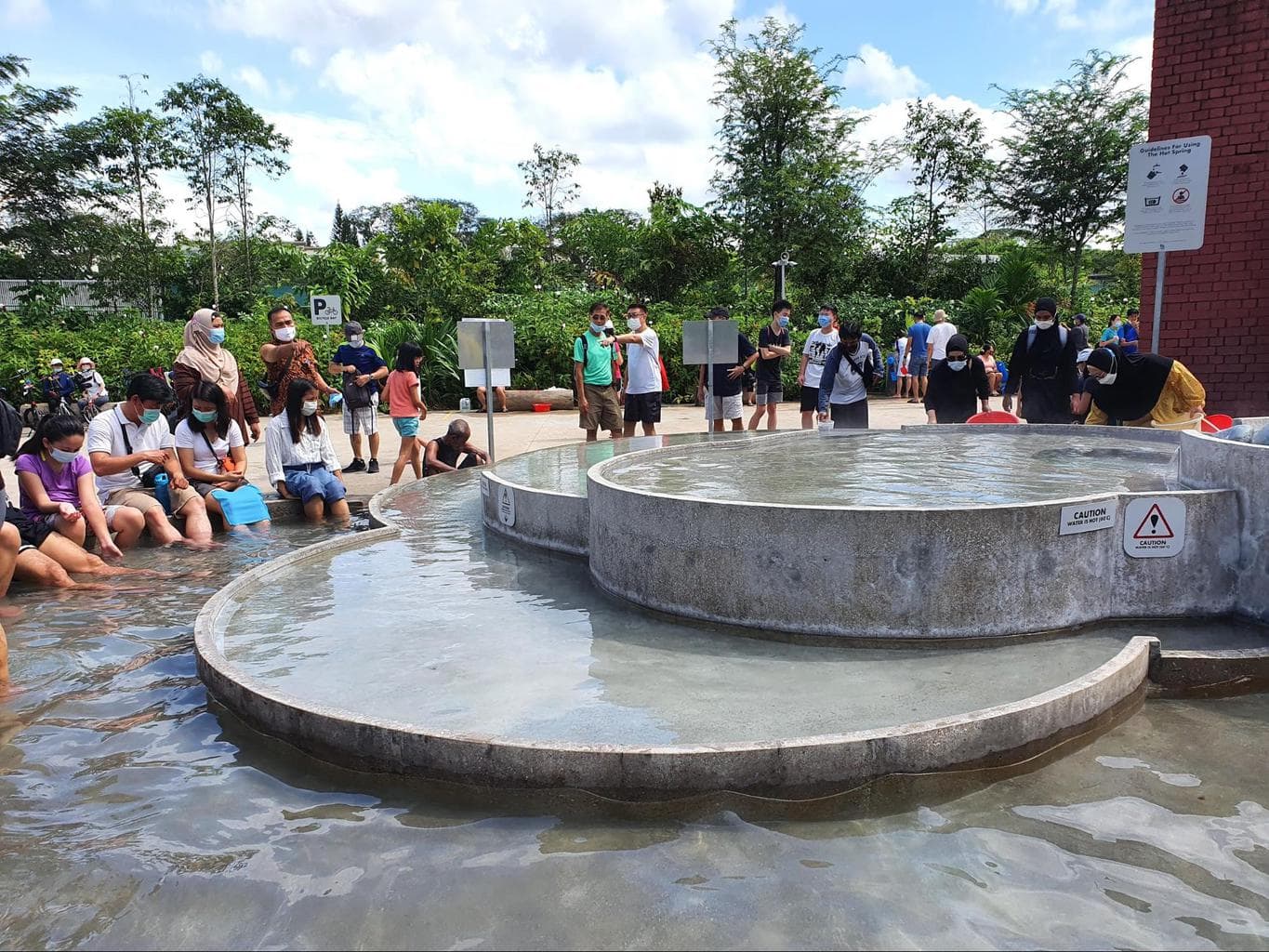
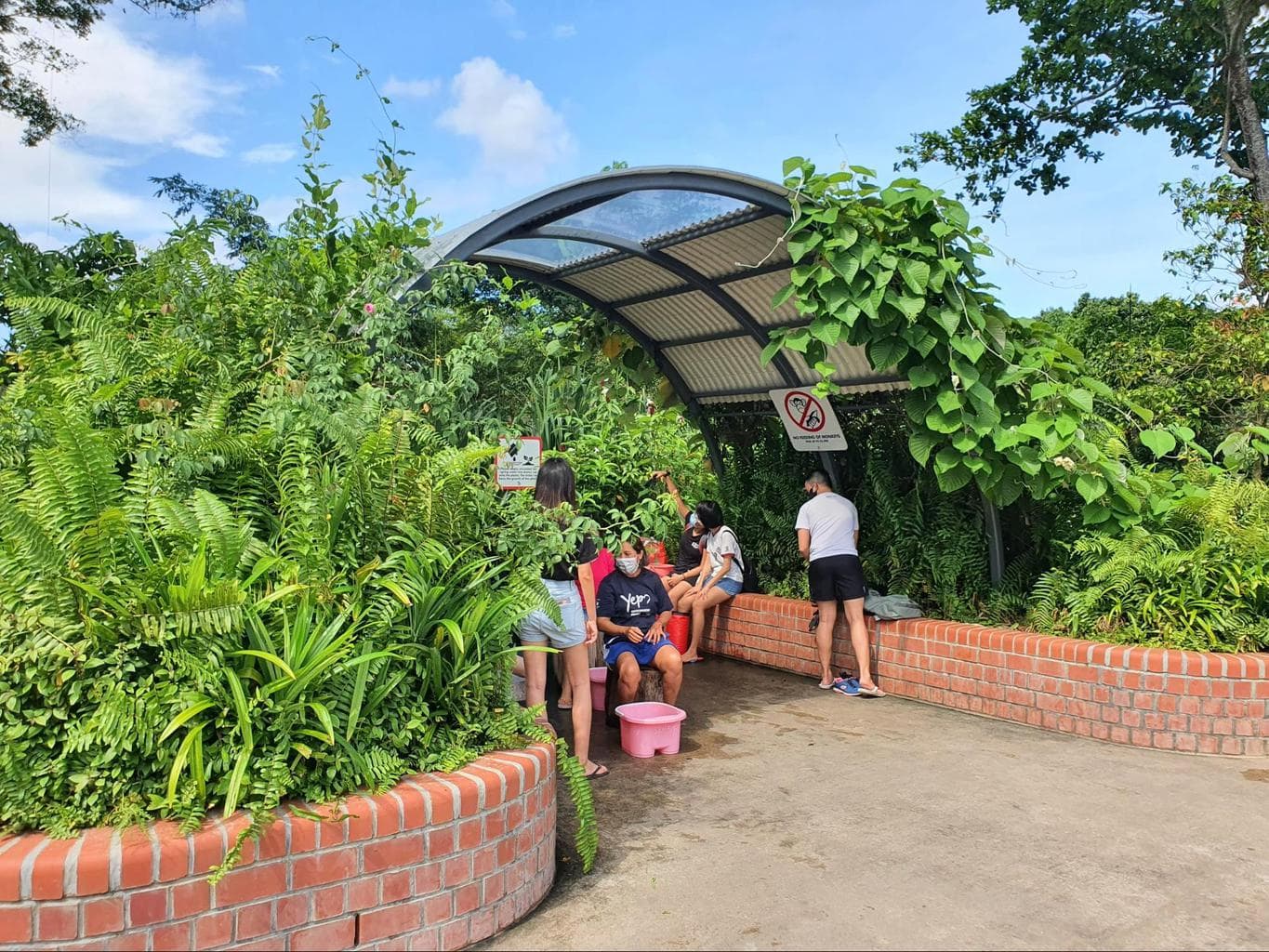
Most visitors who did not bring a bucket sat on the ledge of the 40 degree pool and directly dipped their feet inside the water, nobody sat on the ledge of the other pools simply because they were far too hot. Kids go all in and stand inside the lowest pool which is about 20cm deep.
If you are a pro you should bring your own bucket. This will allow you to enjoy the water at the right temperature for you, far from the packed pool area, in the shade (the pools are in the sun) and for as long as you want (you can’t linger at the pool area because it is packed and there are lots of people who want to enjoy the water).
What type of bucket should you bring to Sembawang Hot Spring Park?
Don’t be like us and bring a bucket like the ones you use to build sand castles, you need to bring one of those buckets you use to wash your clothes, that is, a bucket where you can fit your two feet, or at least one at a time. It shouldn’t be too deep and should be easy enough to carry when filled with hot water.
Now that you got your bucket, fill it with water at the lowest temperature (or higher if you can stand it) and take it with you to one of the shaded areas.
There are a couple of “tunnel-style” rest areas near the pools that are set for this and have concrete benches where you can sit, but if you go on a weekend they will be full.
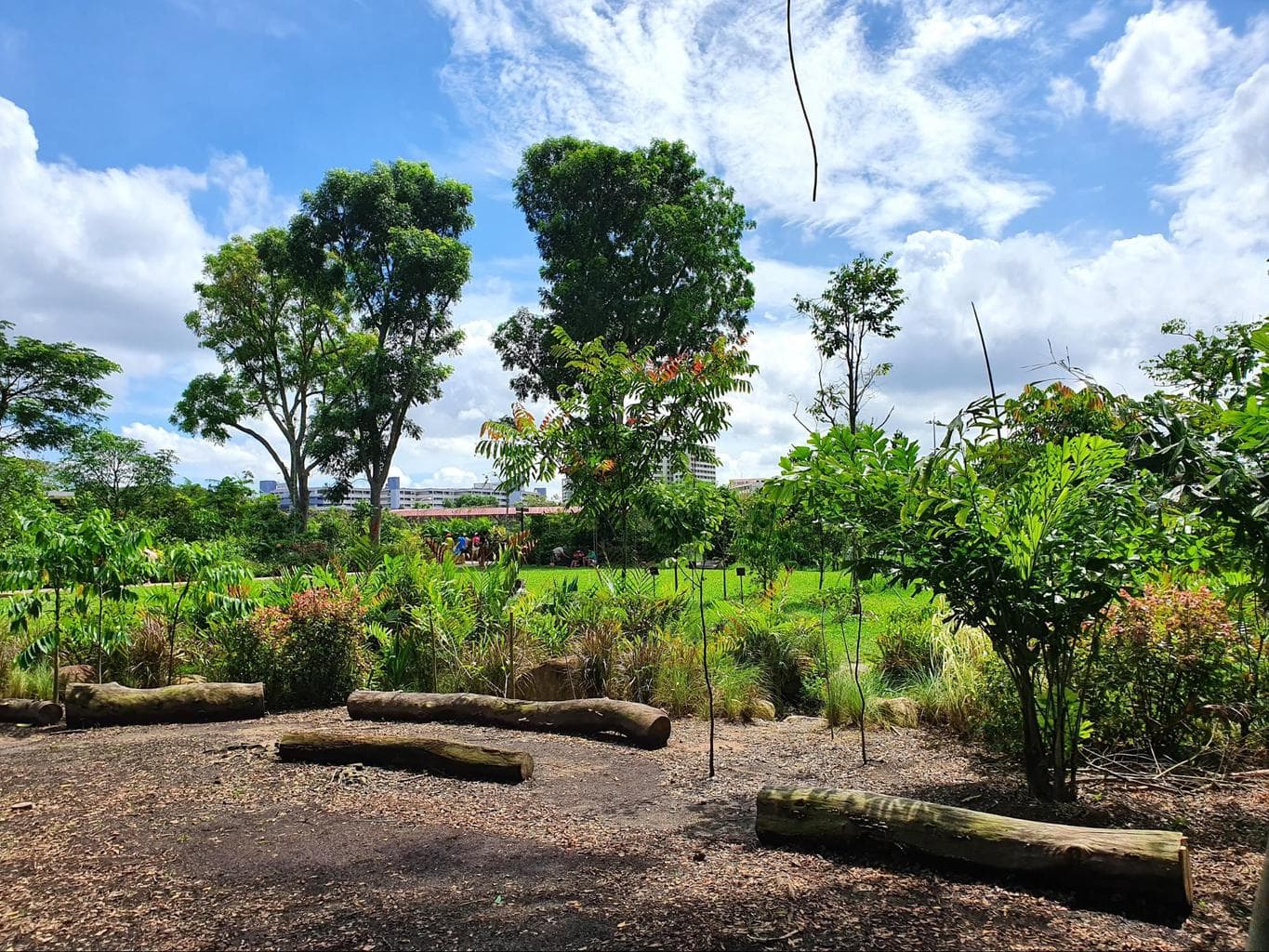
Pro tip: Take your bucket to where the large banyan tree is. It is a shaded, quiet area that does not see a lot of visitors (most people miss the little stepping stones that cross the tiny stream) and is pretty nice.
Floral walk

The walk from the road to the hot spring area is a short 5min path that is lined with lots of colorful flowers, plants and fruit trees that attract beautiful butterflies. NParks did a good job when renovating the area and turned this into a pretty entrance.
You can stop along the way to enjoy the flowers and chase butterflies all while learning about the fruit trees and edible plants via the panels that have been placed there.
The flora chosen for the floral walk tries to bring back the flowers and plants that Singapore’s kampongs saw between the 1960s and 1990s some of which are not so commonly found today. You will also be able to see some tropical fruits such as papaya trees and some unusual ones like zapotes.
I must admit this is the nicest bit of the park which is otherwise a really hot concrete space where you can find little shade and respite beyond the banyan tree.
Egg cooking station
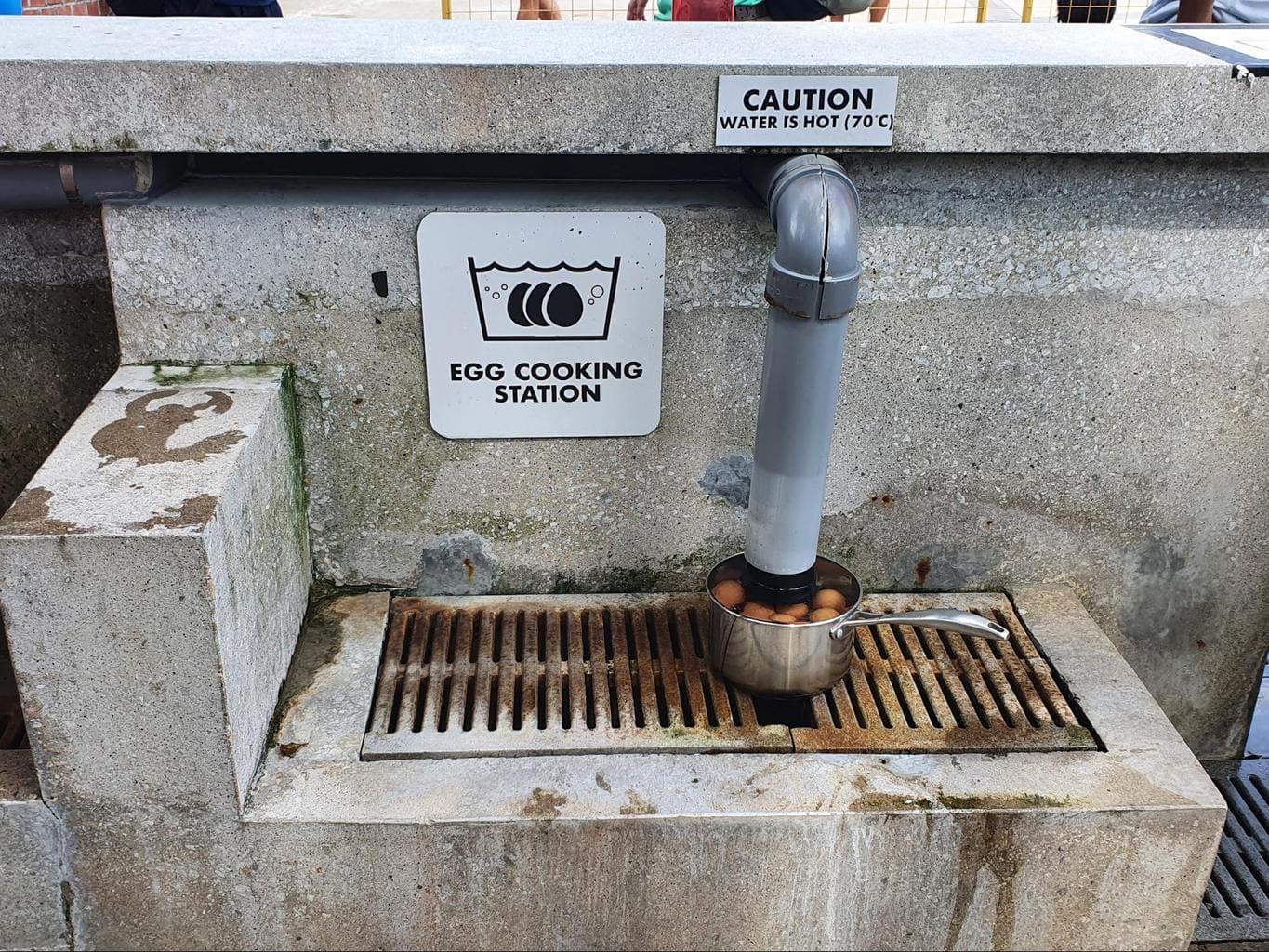
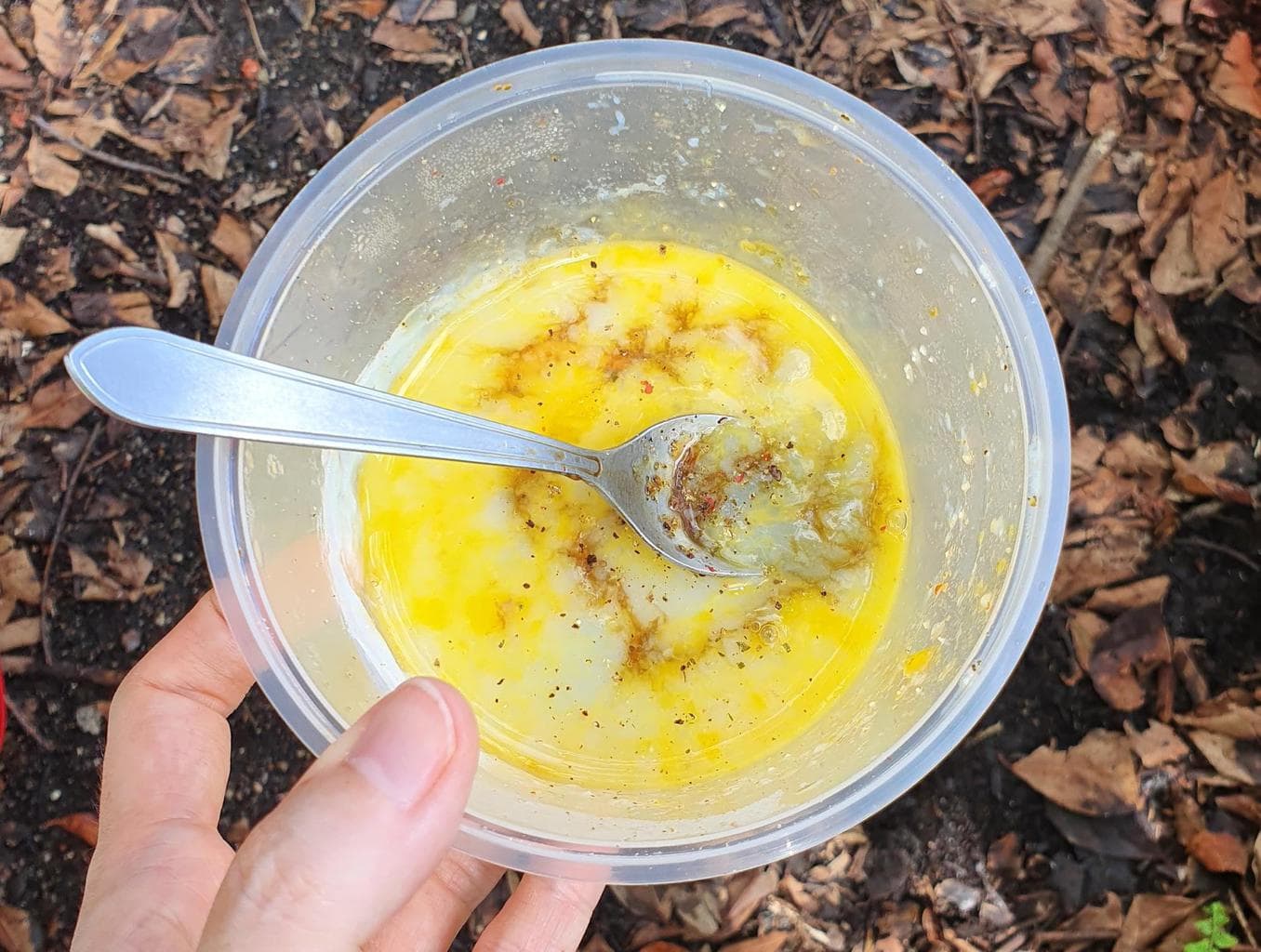
Sembawang Hot Spring also has a small egg cooking station located by the side of the foot bath where water comes out at 70 degrees from about 8 pipes.
I recommend you bring a small bucket or even just a tupperware or a kitchen pot to cook your own eggs either at the cooking station or inside the pools, more for fun than anything else because it is not the most efficient way to cook an egg (it took us almost 60min to cook it to runny level).
If you find a spot in the egg cooking station, you should leave your bucket/tupperware/pot with eggs under one of the pipes so that you cook your eggs fastest with the flowing hot water. Even then, it might still take you 40min+ to get them to a runny level. A bit slower than taking a cooking class in Singapore.
If all spots at the cooking station are taken (default scenario), you might want to break your eggs and place the yolk and egg white in your clean tupperware in your bucket filled with 70 degree water so you can watch them cook that way. We did that after realising that our eggs would never cook by simply being placed in our bucket away from the flowing hot water.
Once your eggs are cooked, sprinkle some pepper, soy sauce, chilli sauce or other condiments to your liking, stir and eat. I brought bread to dip into the eggs and make it a more filling breakfast. If you have kaya, toast and butter, you can enjoy a traditional Singaporean breakfast.
Get lost in the banyan tree maze
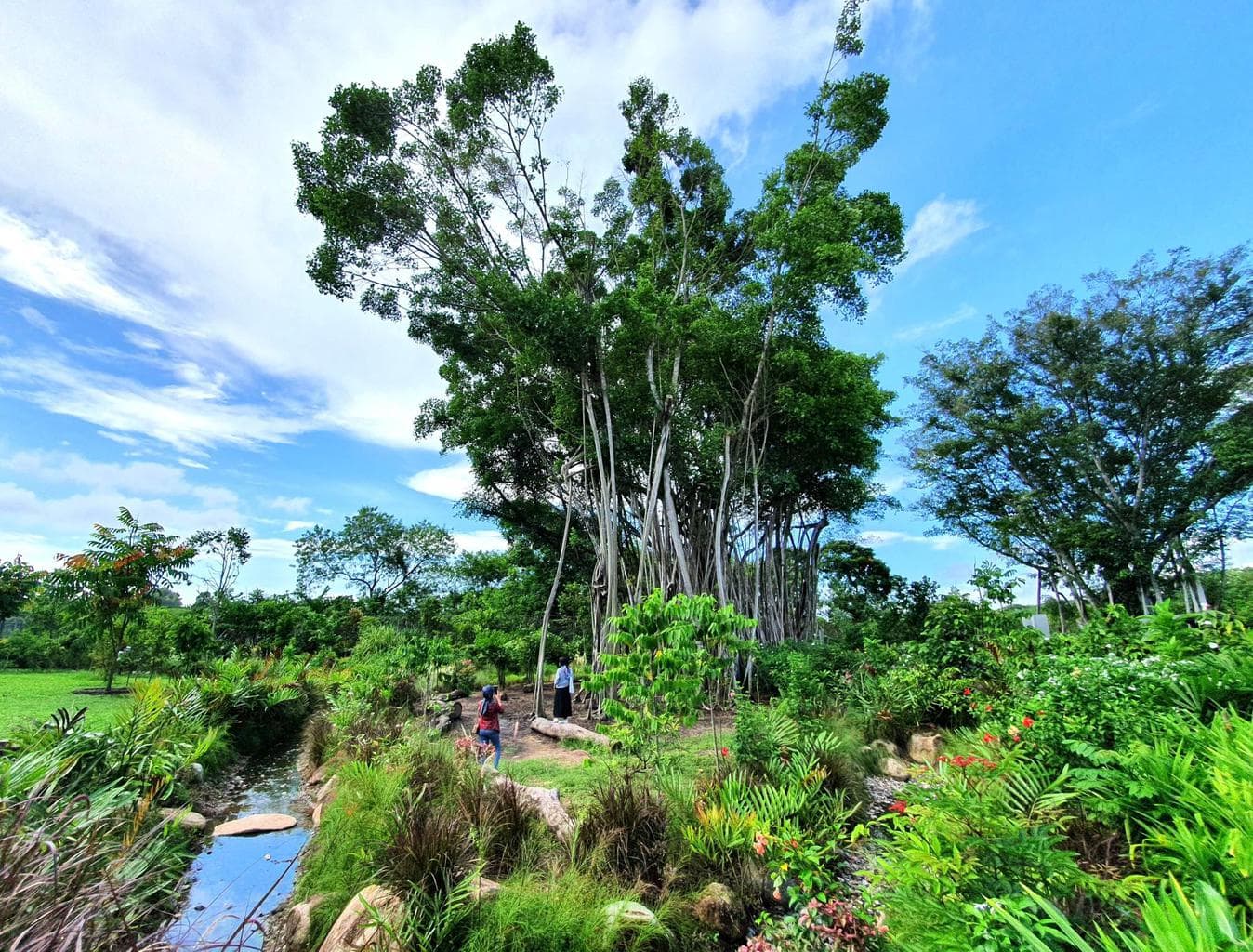
Although not listed as an attraction and rather overlooked, I found the nicest part of the park to be the enormous banyan tree that is located between the floral walk and the hot spring area.
This giant tree is made of many roots and branches and makes for the perfect spot to play a game of hide and seek. Reach it from the back of the egg cooking station or via the stepping stones that cross a flowing river and enjoy the shade, the beautiful tree and the natural maze that the tree’s roots created.
Educational zone
Away from the main pool you will find a spot with a concrete installation signposted for kids to play and learn about the hot spring and underground water. You can pour water on one end and learn how the water flows and goes down and up via the various levels.
Facilities at Sembawang Hot Spring
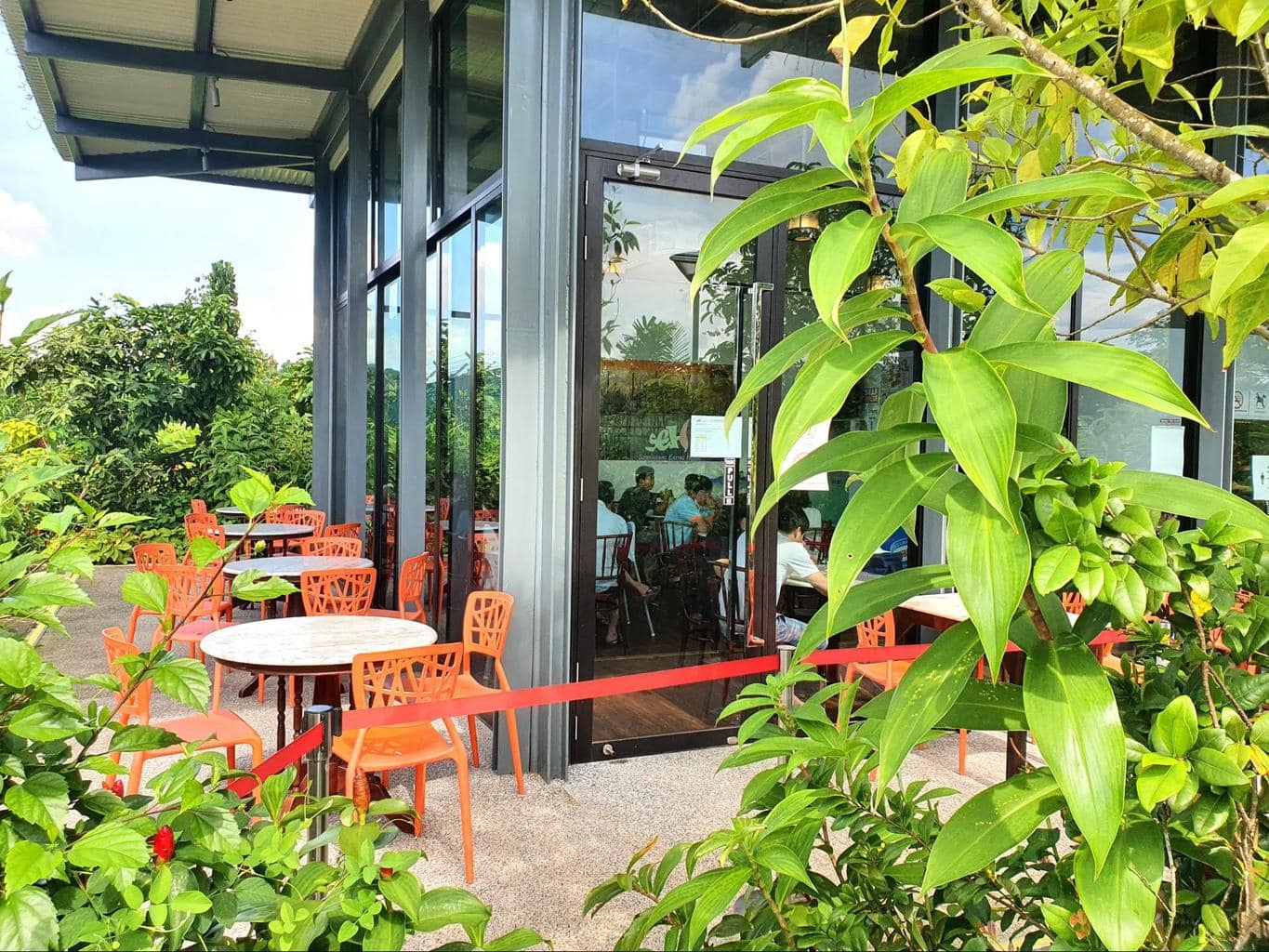
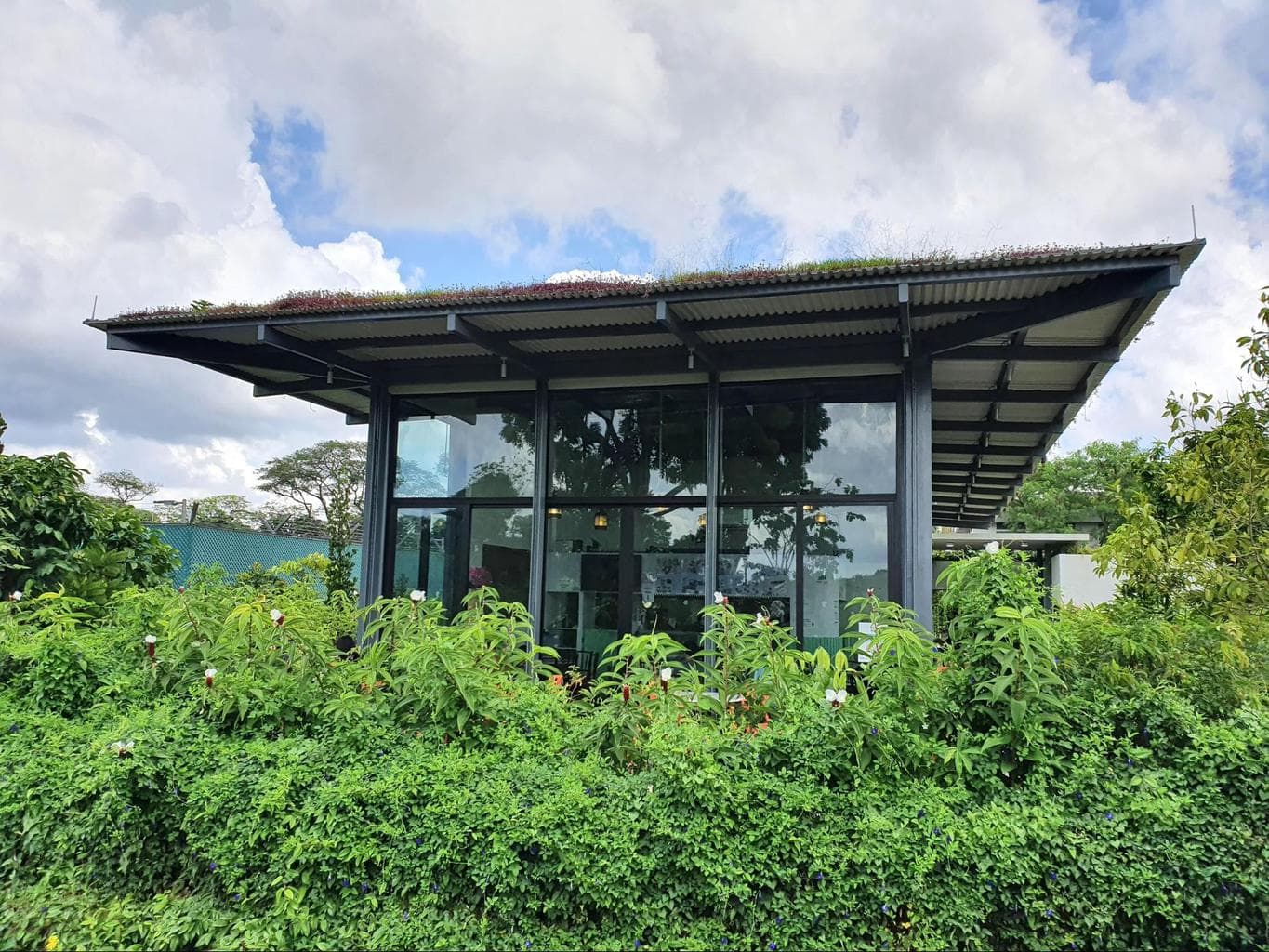
While the park is really tiny, different from some of the better known parks in Singapore, it is well equipped with facilities you would need. There are restrooms and water faucets to wash your feet at the entrance and a hot spring pipe from where you can fill buckets or bottles to take some of the water home (albeit prepare to queue if you go in the weekend, the water pressure is low and people come ready to fill several buckets).
If you cycled to the park, there is a bicycle parking area behind the restrooms where you can easily lock your bike.
If you did not bring your own eggs or get peckish, there is Sembawang Eating House, a small restaurant on site near the entrance selling typical hawker food which has pleasant outdoor tables surrounded by flowers and plants. You could also get take-aways and enjoy it around the banyan tree area.
How to get to Sembawang Hot Spring Park
Sembawang Hot Spring Park is far from the downtown area of Singapore and rather time consuming to get to if you don’t have a car (there is no parking on site) or want to take a taxi.
By taxi, expect around 20-25min to drive from Chinatown to the hot spring, which is a lot for Singapore standards because nothing is ever that far. If you decide to take public transportation, you will need to make it a half day trip.
Use Google maps to plot your most optimal route. The nearest MRT station is Yishun on the red line, which is about 25min away on foot, so MRT + bus tends to be the most efficient way to get there.
If you cycle and don’t live too far, the hot spring is about 1km from the Yishun Park Connector Network so would make for a nice detour.
Frequently asked questions about the Sembawang Hot Spring Park
Below are some of the most commonly asked questions about the hot spring.
Is the Sembawang Hot Spring free?
Yes, the hot spring is in a public park and therefore is free to access by anyone.
What is the best time to visit Sembawang Hot Spring?
I highly recommend you go during the week when the area is much quieter. If you can’t go during the week, then I would suggest going early in the day (8-9am) or later in the day, to avoid the crowds and the heat. On a sunny day, the lack of shade, the concrete floors and the hot water can even make you feel ill.
Can you bathe in the pools?
No, the hot water pools are meant only for your feet and you should not go all in. If you want to wash your body in the medicinal water, bring a bigger bucket and splash yourself away from the pools and the other visitors.
What if I forgot to bring a bucket?
There are signs that state you can borrow buckets from the park however we did not see any, most likely because we went on a Sunday and they were probably all taken or because they have all been lost already, bring your own.
Is the hot spring natural?
Yes, the water comes from 3km below the surface at 70 degrees Celsius and has all the properties of natural hot spring water that makes it popular with those looking for a cure for things like arthritis, psoriasis, etc.
When does the hot spring park open or close?
Sembawang Hot Spring Park is open from 7am to 7pm and the eating house opens from 8am to 8pm daily.
- Check if you need a visa, get help processing it at iVisa.
- Never ever leave without travel insurance. Get affordable coverage from World Nomads or long term insurance from Safety Wing.
- I find all of my flights on KAYAK. Check their Deals section too.
- Search for all your transportation between destinations on the trusted travel booking platform Bookaway.
- I book all my day trips and tours via GetYourGuide, they are the best and their tours are refundable up to 24h in advance.
- Get USD35 off your first booking with Airbnb.
- Compare hotels EVERYWHERE at HotelsCombined and book with Booking.com.
- Compare car rental prices at Rentalcars.com
